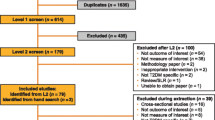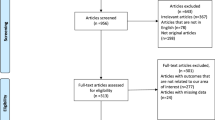Abstract
Aims
To study the association of circulating β2 (B2M) and α1 microglobulins (A1M) with diabetic nephropathy (DN) progression, a meta-analysis was performed on the prospective cohort studies.
Methods
Up to October 2021, a comprehensive search of the PubMed, EMBASE, Scopus, Web of Science, and Cochrane Library databases was performed. The primary outcome (progression of DN) was defined as a decrease in eGFR or the occurrence of end stage renal disease or DN-related mortality. Eligible studies were included in a pooled analysis that used either fixed-effect or random-effect models to compensate for variation in measurement standards between studies. The funnel plot and Egger's test were used to assess publication bias.
Results
The meta-analysis included 4398 people from 9 prospective trials (8 cohorts) for B2M and 3110 people from 4 prospective trials (3 cohorts) for A1M. Diabetic individuals with higher B2M levels had an increased risk for DN (relative risk [RR]: 1.81, 95% confidence interval [CI]: 1.56–2.09). Likewise, higher A1M was associated with augmented probability of DN (RR: 1.96, 95% CI: 1.46–2.62). The funnel plot and Egger’s tests indicated no publication bias for A1M. Additionally, to compensate for putative publication bias for B2M, using trim and fill analysis, four studies were filled for this marker and the results remained significant (RR: 1.62, 95% CI: 1.37–1.92).
Conclusions
The elevated serum levels of B2M and A1M could be considered as potential predictors of DN progression in diabetic patients.
Protocol registration: PROSPERO CRD42021278300.



Similar content being viewed by others
References
Glassock RJ, Winearls C (2008) Screening for CKD with eGFR: doubts and dangers. Clin J Am Soc Nephrol 3:1563–1568
Vallon V, Thomson SC (2020) The tubular hypothesis of nephron filtration and diabetic kidney disease. Nat Rev Nephrol 16:317–336
Laranjinha I, Matias P, Mateus S et al (2016) Diabetic kidney disease: is there a non-albuminuric phenotype in type 2 diabetic patients?. Nefrologia: Publicacion oficial de la Sociedad Espanola Nefrologia, 36: 503–509
MacIsaac RJ, Ekinci EI, Jerums G (2014) Progressive diabetic nephropathy. How useful is microalbuminuria?: contra. Kidney Int 86:50–57
Peterson PA, Evrin P-E, Berggård I (1969) Differentiation of glomerular, tubular, and normal proteinuria: determinations of urinary excretion of β 2-microglobulin, albumin, and total protein. J Clin Investig 48:1189–1198
Portman RJ, Kissane JM, Robson AM, Richardson A (1986) Use of β2 microglobulin to diagnose tubulo-interstitial renal lesions in children. Kidney Int 30:91–98
Andersson L, Haraldsson B, Johansson C, Barregard L (2007) Methodological issues on the use of urinary alpha-1-microglobuline in epidemiological studies. Nephrol Dial Transplant 23:1252–1256
Kaye W, Griffiths W, Camara P, Trebbin W, Solomon R, Diamond I (1981) The significance of beta-2 microglobulinuria associated with gentamicin therapy. Ann Clin Lab Sci 11:530–537
Wibell L, Evrin PE, Berggård I (1973) Serum β<sub>2</sub>-microglobulin in renal disease. Nephron 10:320–331
Barton KT, Kakajiwala A, Dietzen DJ, Goss CW, Gu H, Dharnidharka VR (2018) Using the newer kidney disease: improving global outcomes criteria, beta-2-microglobulin levels associate with severity of acute kidney injury. Clin Kidney J 11:797–802
Hong CY, Hughes K, Chia KS, Ng V, Ling SL (2003) Urinary alpha1-microglobulin as a marker of nephropathy in type 2 diabetic Asian subjects in Singapore. Diabetes Care 26:338–342
Petrica L, Vlad A, Gluhovschi G et al (2014) Proximal tubule dysfunction is associated with podocyte damage biomarkers nephrin and vascular endothelial growth factor in type 2 diabetes mellitus patients: a cross-sectional study. PLoS ONE 9:e112538
Moher D, Liberati A, Tetzlaff J, Altman DG, Group P (2009) Preferred reporting items for systematic reviews and meta-analyses: the PRISMA statement. PLoS Med 6:e1000097
Higgins JP, Thompson SG (2002) Quantifying heterogeneity in a meta-analysis. Stat Med 21:1539–1558
Higgins JP, Thompson SG, Deeks JJ, Altman DG (2003) Measuring inconsistency in meta-analyses. BMJ 327:557–560
Sterne JA, Gavaghan D, Egger M (2000) Publication and related bias in meta-analysis: power of statistical tests and prevalence in the literature. J Clin Epidemiol 53:1119–1129
Duval S, Tweedie R (2000) Trim and fill: a simple funnel-plot–based method of testing and adjusting for publication bias in meta-analysis. Biometrics 56:455–463
Parrinello CM, Matsushita K, Woodward M, Wagenknecht LE, Coresh J, Selvin E (2016) Risk prediction of major complications in individuals with diabetes: the atherosclerosis risk in communities study. Diabetes Obes Metab 18:899–906
Colombo M, McGurnaghan SJ, Blackbourn LAK et al (2020) Comparison of serum and urinary biomarker panels with albumin/creatinine ratio in the prediction of renal function decline in type 1 diabetes. Diabetologia 63(788):798
Colombo M, Valo E, McGurnaghan SJ et al (2019) On behalf of the FinnDiane study G, the Scottish diabetes research network type 1 Bioresource C. Biomarker panels associated with progression of renal disease in type 1 diabetes. Diabetologia 62:1616–1627
Looker HC, Colombo M, Hess S et al (2015) Biomarkers of rapid chronic kidney disease progression in type 2 diabetes. Kidney Int 88(888):896
Bjornstad P, Pyle L, Cherney DZI et al (2018) Plasma biomarkers improve prediction of diabetic kidney disease in adults with type 1 diabetes over a 12-year follow-up: CACTI study. Nephrol, Dial, Trans: Official Publ Euro Dial Trans Assoc-Euro Renal Assoc 33(1189):1196
Cheung CL, Lam KS, Cheung BM (2013) Serum β-2 microglobulin predicts mortality in people with diabetes. Eur J Endocrinol 169:1–7
Foster MC, Inker LA, Hsu CY et al (2015) Filtration markers as predictors of ESRD and mortality in Southwestern American Indians with type 2 diabetes. Am J Kidney Diseases: Official J Natl Kidney Found 66:75–83
Colombo M, Looker HC, Farran B et al (2019) on behalf of the SI. Serum kidney injury molecule 1 and β2-microglobulin perform as well as larger biomarker panels for prediction of rapid decline in renal function in type 2 diabetes. Diabetologia 62:156–168
Robles NR, Villa J, Gallego RH (2015) Non-proteinuric diabetic nephropathy. J Clin Med 4:1761–1773
Chen C, Wang C, Hu C et al (2017) Normoalbuminuric diabetic kidney disease. Front Med 11:310–318
Argyropoulos CP, Chen SS, Ng Y-H et al (2017) Rediscovering beta-2 microglobulin as a biomarker across the spectrum of kidney diseases. Front Med 2017;4
Colombo M, Looker HC, Farran B et al (2019) Serum kidney injury molecule 1 and β2-microglobulin perform as well as larger biomarker panels for prediction of rapid decline in renal function in type 2 diabetes. Diabetologia 62:156–168
Foster MC, Coresh J, Hsu C-Y et al (2016) Serum β-trace protein and β2-microglobulin as predictors of ESRD, mortality, and cardiovascular disease in adults with CKD in the chronic renal insufficiency cohort (CRIC) study. Am J Kidney Dis: Official J Natl Kidney Found 68:68–76
Inker LA, Coresh J, Sang Y et al (2017) (2017) Filtration markers as predictors of esrd and mortality: individual participant data meta-analysis. Clin J Am Soc Nephrol: CJASN 12:69–78
Acknowledgements
AG and YG participated in design, data gathering, analysis, interpretation of data and drafting the manuscript. SM contributed to design, data gathering, interpretation of data and drafting the manuscript. AR participated in data gathering and drafting the manuscript. RN participated in comprehensive data searching and collection. MMo and MMa contributed to study design and analysis of the data, respectively. The final version of the manuscript was reviewed and confirmed by all authors. The authors report no conflict of interest. Authors received no fund for this study.
Funding
No funding was received to assist with the preparation of this manuscript.
Author information
Authors and Affiliations
Corresponding author
Ethics declarations
Conflict of interest
The authors declare they have no financial interests.
Ethical Standard
This study is approved by our university ethics committee (IR.ARI.MUI.REC.1401.077).
Informed consent
For this type of study, formal consent is not required.
Additional information
This article belongs to the Topical Collection "Diabetic Nephropathy", Managed by Giuseppe Pugliese.
Publisher's Note
Springer Nature remains neutral with regard to jurisdictional claims in published maps and institutional affiliations.
Supplementary Information
Below is the link to the electronic supplementary material.
Rights and permissions
Springer Nature or its licensor holds exclusive rights to this article under a publishing agreement with the author(s) or other rightsholder(s); author self-archiving of the accepted manuscript version of this article is solely governed by the terms of such publishing agreement and applicable law.
About this article
Cite this article
Gholaminejad, A., Moein, S., Roointan, A. et al. Circulating β2 and α1 microglobulins predict progression of nephropathy in diabetic patients: a meta‐analysis of prospective cohort studies. Acta Diabetol 59, 1417–1427 (2022). https://doi.org/10.1007/s00592-022-01940-w
Received:
Accepted:
Published:
Issue Date:
DOI: https://doi.org/10.1007/s00592-022-01940-w




